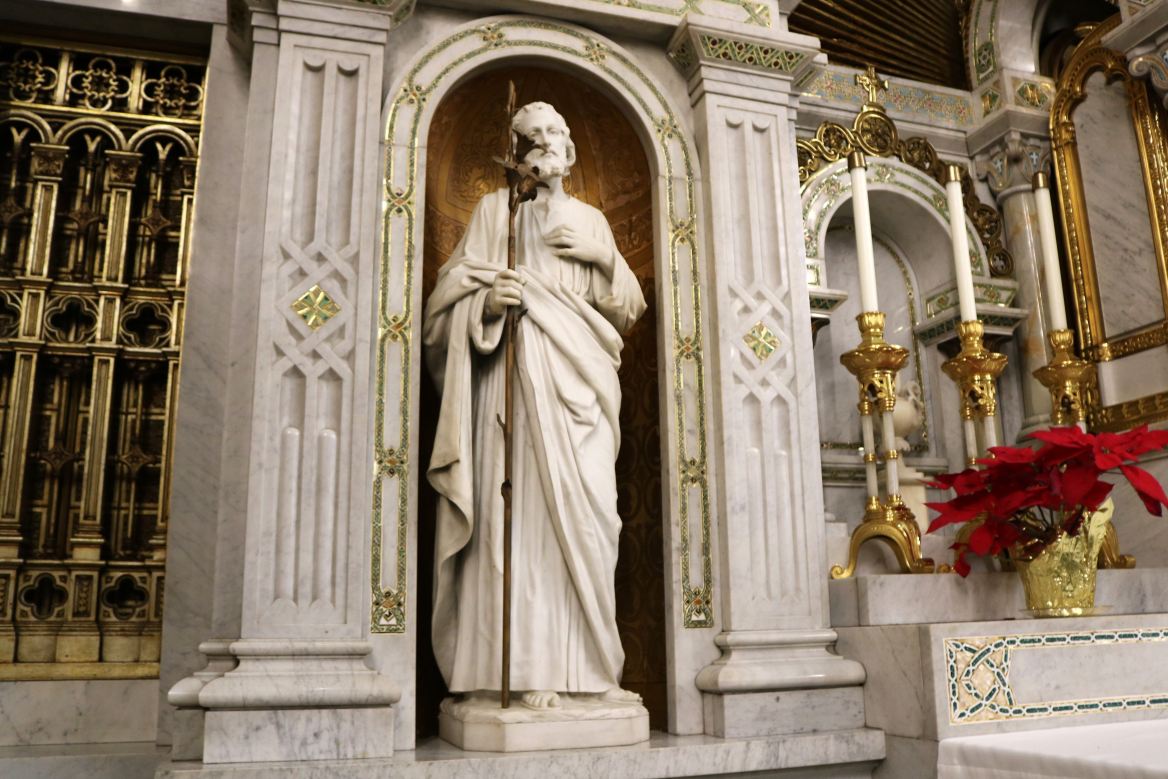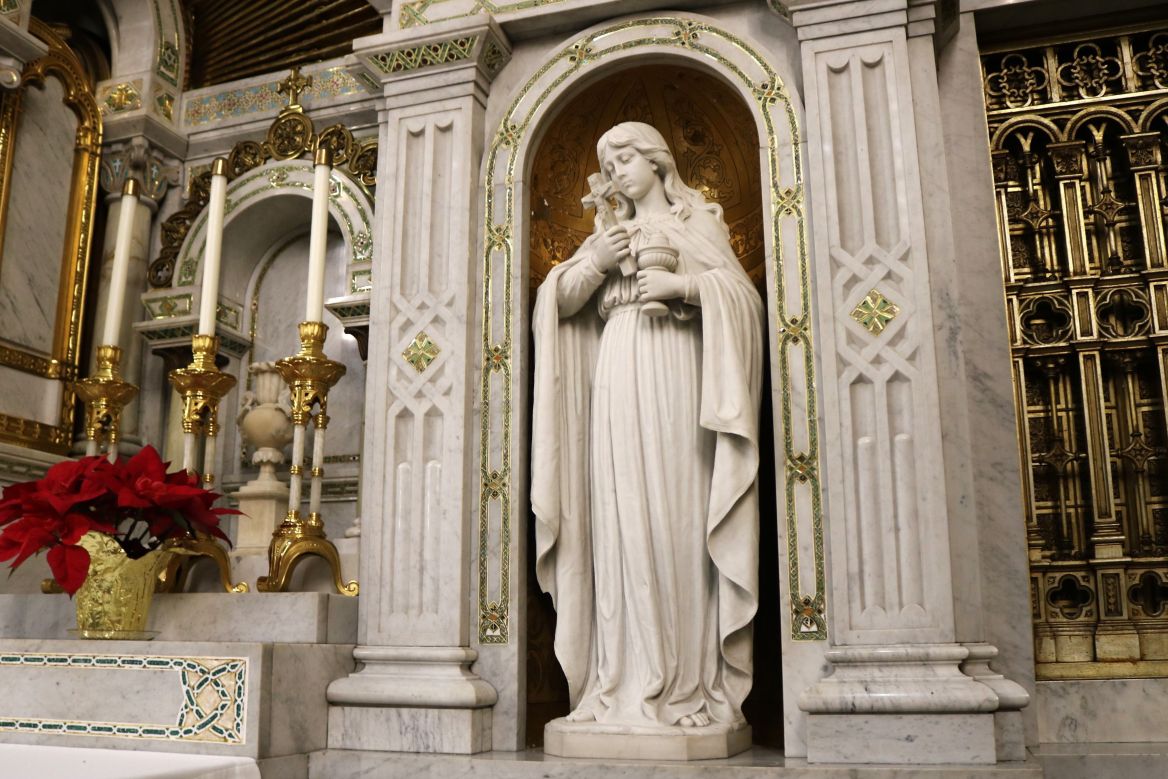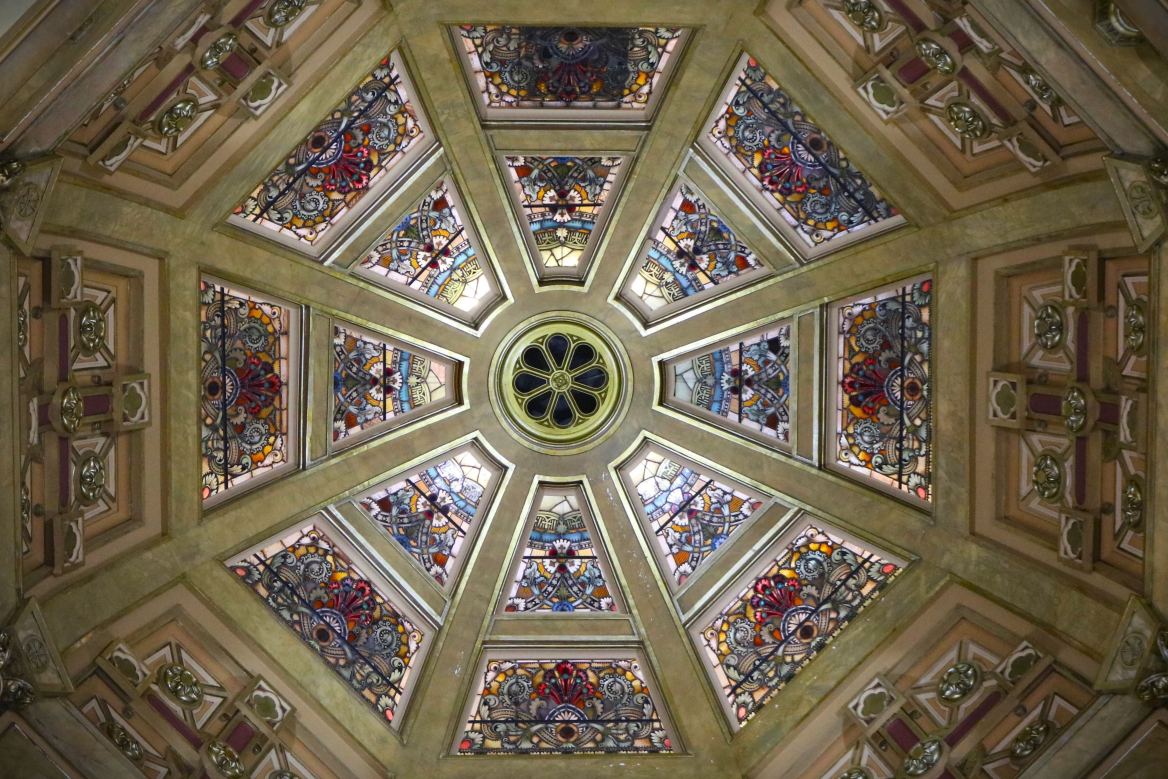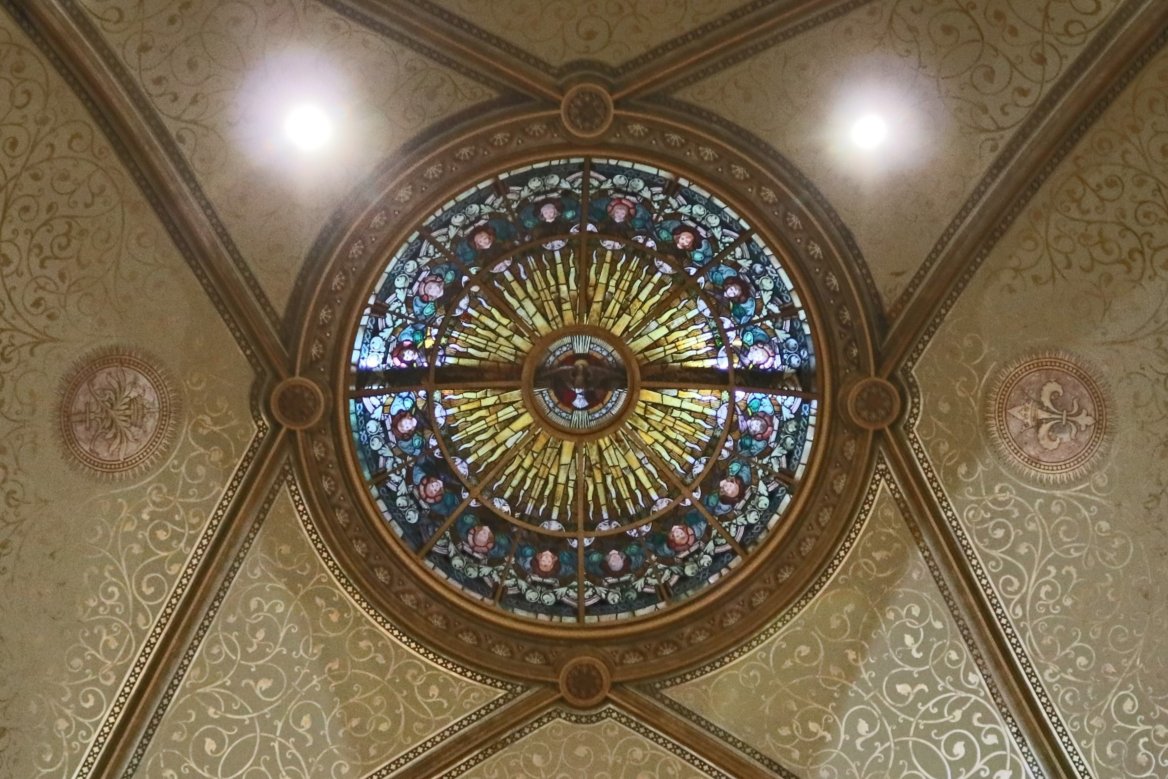Our Chapels
St. Rose Convent, built in 1870, serves as the spiritual heart and administrative center for the Franciscan Sisters of Perpetual Adoration. Although the congregation's sisters minister throughout the United States and beyond, Mary of the Angels Chapel and the Perpetual Adoration Chapel unite them all in prayer for each other, the church and the world.
Mary of the Angels Chapel:
Mary of the Angels (Maria Angelorum) Chapel located at St. Rose Convent in La Crosse, Wisconsin was consecrated on Aug. 2, 1906, and serves as the place of prayer for the Franciscan Sisters of Perpetual Adoration. The name "Mary of the Angels" was chosen for the chapel before many of the images of angels were introduced into the plans. According to most counts, over 160 unique angel figures can be found throughout the chapel in paintings, windows and statues. Enjoy taking a virtual tour through our chapels via the photos and videos below.
Our emerging promise
Since recording the above video, we've offered an emerging promise of adoration. Through February 25, 2020, continuously, day and night, at least two people prayed before the Blessed Sacrament. Today, we continue adoration before the Blessed Sacrament daily 6 a.m. to 10 p.m. in our Adoration Chapel. It is a way of maintaining awareness of God's presence in our lives and praying for the community, the city of La Crosse, Wisconsin, the church and the world. Each person has a human need to adore. It is one's response when contemplating all the wonder that is in daily life. This tradition of perpetual adoration reminds us of God's presence in our lives and our need to be present in others' lives.
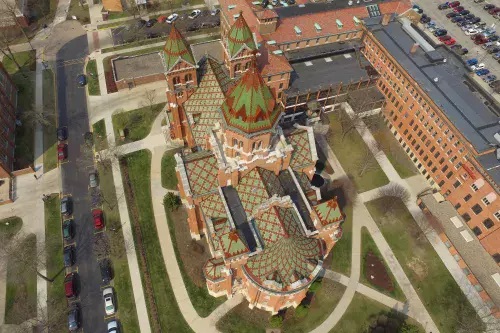
Architecture
Mary of the Angels Chapel and the Perpetual Adoration Chapel together comprise 6,000 square feet of St. Rose Convent. Their Romanesque architecture was developed by architect Eugene R. Liebert. Adolph Liebig decorated, Bernhardt Hillig, Sr., painted and Egid Hackner designed statues, built alters and carved wood.
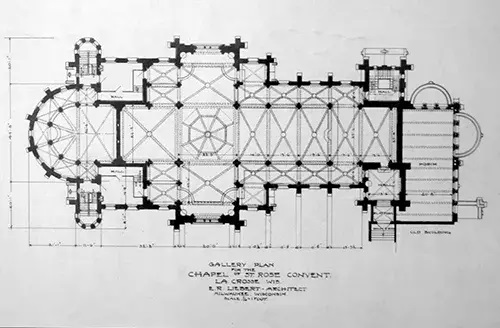
Design
The chapel is cruciform in design with nave, apse (part of which is separated from the sanctuary to constitute the Perpetual Adoration Chapel), and transepts. This architectural drawing of the chapel was found in 2005 and presented to FSPA as a gift celebrating the 100th anniversary of the dedication of the chapel.
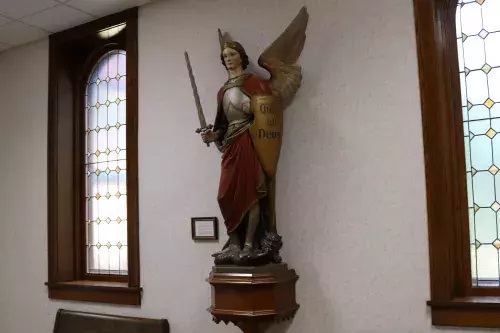
Statue of St. Michael the Archangel
A statue of St. Michael the Archangel was placed in the vestibule just outside the main doors of Mary of the Angels Chapel with instructions from an early leader, Mother Antonia Herb, to guard and protect the sacred spaces. In 1923, a fire threatened to destroy St. Rose Convent. Though the fire destroyed the west wing of the building, it stopped just short of the vestibule where St. Michael stood guard. That corridor and the chapels beyond were untouched by the fire.
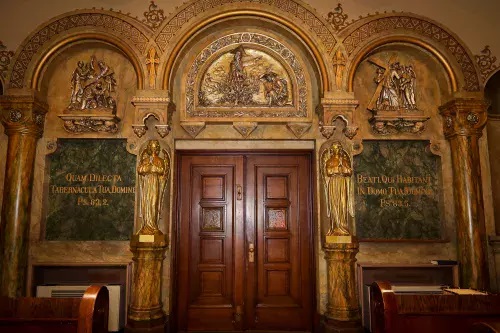
Entrance
As one enters the chapel and turns to view the area just above the entrance door, a relief of Moses before the burning bush reminds the worshiper that this is a space in which God wishes to commune with his creatures and family. The entrance is also flanked on each side by two of the 163 angels found in Mary of the Angels Chapel.
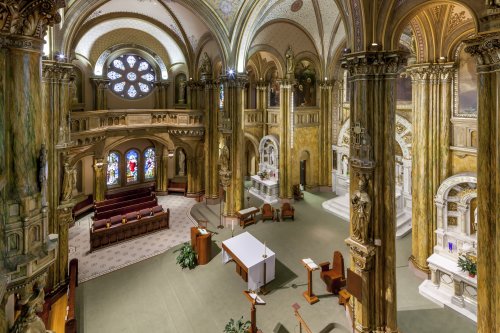
Pillars and Columns
The chapel pillars are Corinthian in style, distinguished by rich capitals and formed by Acanthus leaves. Wreathed within the leaves are figures of praying angels. The concrete columns resemble Norwegian marble. Nineteen different processes were employed to produce this beautiful marble effect.
Liturgical Furnishings
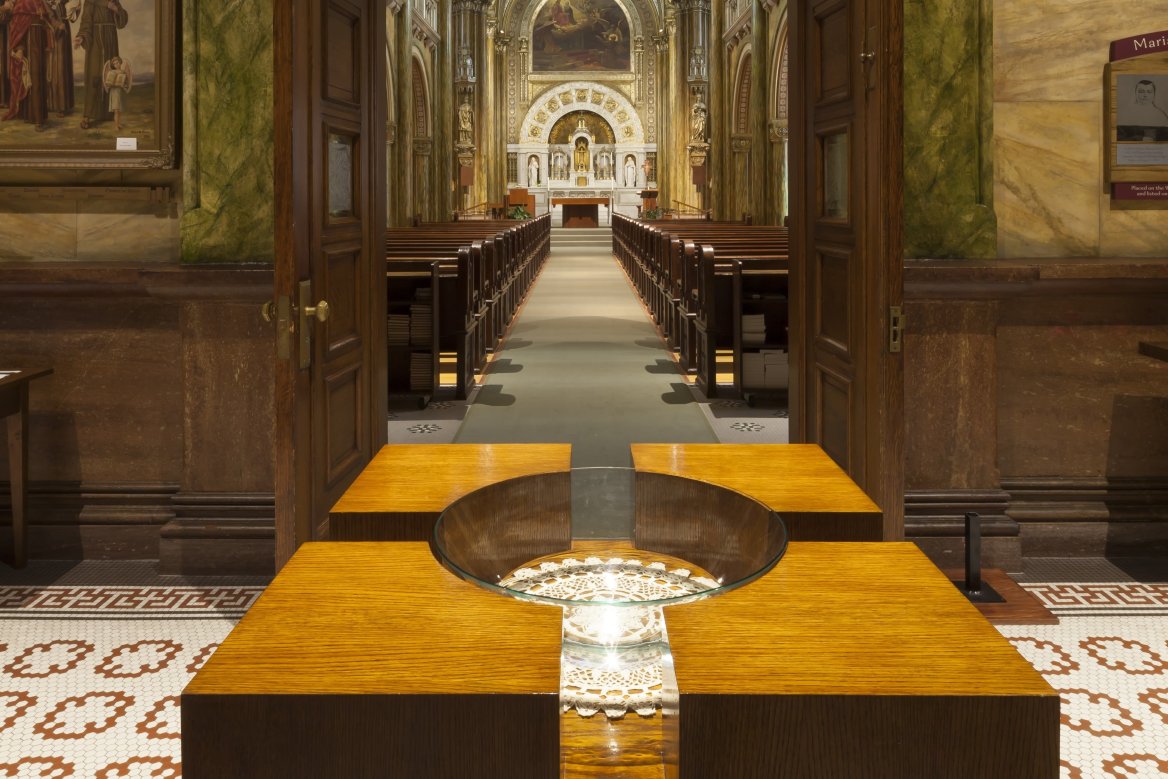
Baptismal Font
In recent years, the baptismal font, designed in the early 1990s, has been placed in the entryway, as it is here, to remind those entering that they are called to a life of holiness by virtue of their baptism. It is not only vowed religious persons who are called, but all Christians through their baptism.
Pews
The woodwork found in Mary of the Angels Chapel is the result of the craftsmanship of the workers employed by the Hackner Alter Company. A Greek cross and a sculpted rose, a symbol of Mary, adorn each hand-carved, red oak pew. The egg and dart decorative design, seen on the pew arms, represents life and suffering. Power tools were not introduced in the Hackner Factory until 1910, so all of the woodwork found in the chapel was created entirely by hand.
Altars
The original Mary of the Angels Chapel altars are constructed of fine Italian marble and decorated with gold bronze, onyx pillars and inlaid mosaics of green and gold Venetian glass and mother of pearl. The three Venetian mosaics located on the front of the main marble altar symbolize the Eucharist, and the two statues, located on either side of the revolving tabernacle, represent St. Joseph and St. Mary Magdalene.
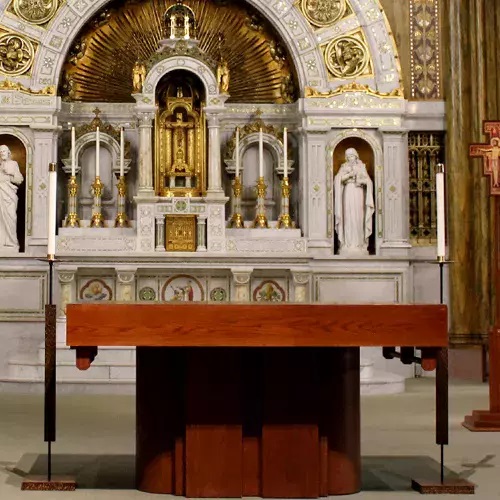
Side Altars
The Sacred Heart Altar, dedicated to the Sacred Heart of Jesus, and the Blessed Mother Altar, dedicated to the Immaculate Mother of God, harmonize well with the main altar in ornamentation, architectural design and beauty of construction. The statues of the altars are of Carrara marble, imported from Italy and executed from models furnished by the Hackner Altar Company.
Altar of Sacrifice
After the liturgical renewal of the 1960s, the altar of sacrifice was placed under the central dome. Simple in design, it stands as a strong and dignified piece. It is on this altar that the mystery of Christ is celebrated in every Mass.
Mosaics
Composed of green and gold Venetian glass and mother of pearl, the central medallion located on the front of the main altar represents the story of the high priest Melchizedek offering bread and wine, as recorded in the Hebrew scriptures. The medallion on the left symbolizes the loaves and fishes, and the one on the right, the wheat and grapes.
Statue of St. Joseph
The statue of St. Joseph holds a place of honor at the left side of the main altar. St. Joseph is honored as a protector of the Holy Family and as a guide and protector for congregations of women religious. Evidence of his aid in FSPA history demonstrates his fatherly interest in the well-being of the congregation.
Statue of St. Mary Magdalene
The statue of St. Mary Magdalene is located on the right side of the main altar. The statue was selected by Mother Ludovica as a response to the critics of the time who said the sisters were spending too much on a building. St. Francis of Assisi had a special devotion to St. Mary Magdalene and named some of his chapels in her honor.
Paintings
Paintings in the sanctuary represent the three divisions of the Franciscan Order: The Friars Minor, Poor Clares and Third Order Regular and Secular. They are all offerings from the studio of the nationally renowned artist Thaddeus von Zukotynski of Chicago. Zukotynski possessed the ability to represent his characters as graceful, dignified figures, sustained with dramatic truth and grandly conceived.

St. Francis of Assisi (Portiuncula) Painting
The large painting on the far wall above the main altar depicts St. Francis of Assisi, founder of the Franciscan Order, at prayer in the little Chapel of Portiuncula as he is favored with a vision of Jesus and Mary surrounded by angelic hosts. This special grace came to be known as the Portiuncula Indulgence.
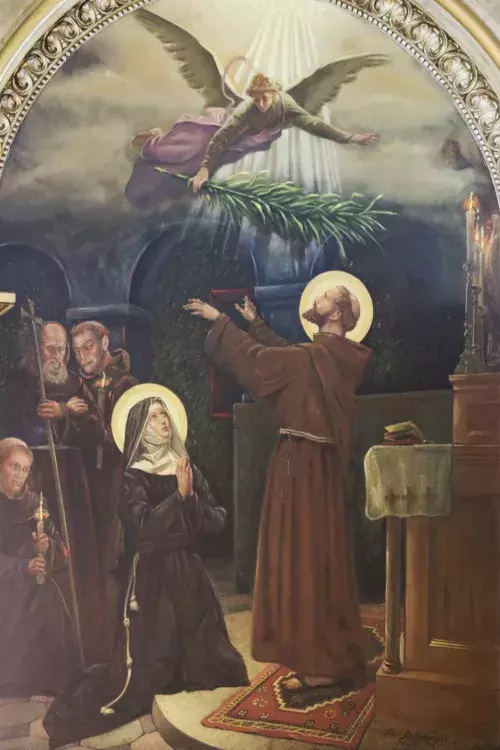
St. Clare and Second Order Franciscans Painting
The work on the north wall of the sanctuary represents the event that marks the beginning of the Second Order of St. Francis, popularly known as the Poor Clares. On Palm Sunday, 1212, Clare presented herself to Francis and his followers in Assisi and received the coarse habit and knotted cord signifying her commitment to a life of poverty and simplicity.

Third Order Franciscans Painting
This painting, displayed on the south wall, depicts St. Louis of France (1215-1270) and St. Elizabeth of Hungary (1207-1231), 12th century tertiaries, meeting with St. Francis of Assisi. St. Elizabeth is shown receiving the Franciscan cord, which symbolizes her following of Francis in devotion to Jesus and charity to the poor.
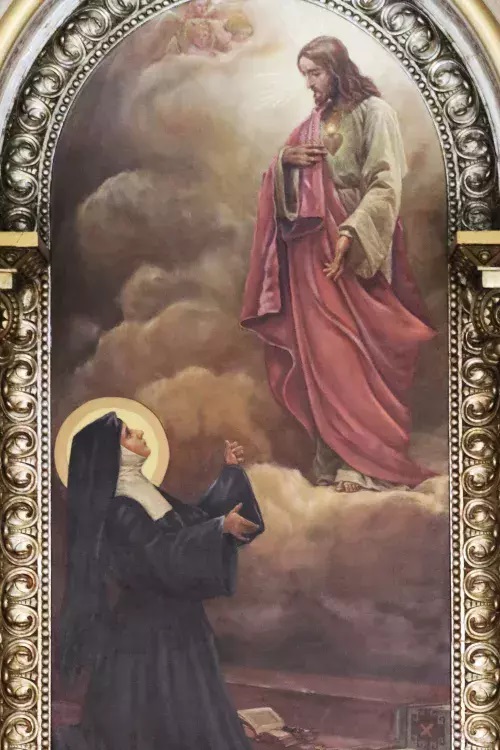
Apparition of Jesus to St. Margaret Mary Painting
Located just above the Sacred Heart Altar, is a representation of Jesus appearing to St. Margaret Mary Alacoque (1647-1690) in which He asks the faithful to honor Him. The soldier's lance shown piercing the heart of Jesus is a symbol of God's great love and mercy for all women and men.
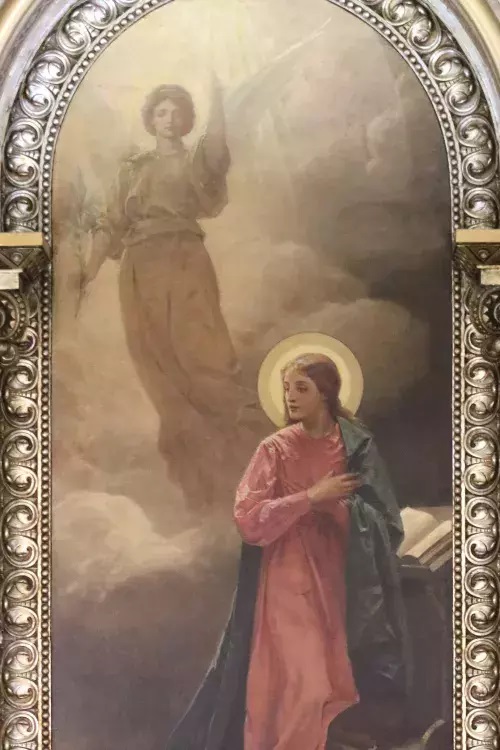
Annunciation of the Blessed Virgin Painting
Just above the Blessed Mary Altar appears a companion piece to the Apparition of Jesus to St. Margaret Mary. This painting illustrates the Gospel story of the angel Gabriel's message to Mary that she is to be the mother of the Son of God. Her response of yes set the whole world on a new course of redeeming love in human form.
Windows/Stained Glass
The Mary of the Angels and Perpetual Adoration Chapels feature more than 100 windows made of Bavarian stained glass, furnished by the Royal Bavarian Art Institute of Munich, Bavaria, Germany. The windows are made of "old glass," which means that the glass was blown in cylinders, then cut and flattened to the size needed for each piece. Depictions of the life of Jesus, Mary and various saints, as well as Bible parables and symbols of the theological virtues of faith, hope and charity can be found within the windows throughout the chapels.
Stained Glass Dome
This stained-glass window portrays the Holy Spirit of God descending in a stream of light surrounded by heads of winged cherubs. Six sides of the dome represent the six days of creation, the seventh side represents God's resting and the eighth side represents the resurrection of the faithful assured by their baptism.
Sanctuary Skylight
The vaulted skylight is surrounded by four ornamental medallions: the liturgical symbols of the Bible, the Keys of God's Kingdom; the Cross of Christ; the Crown of Glory; and the fleur-de-lis, a symbol of the Blessed Virgin Mary. The sanctuary ceiling is finished in gold filigree on a background of blue.
Statues
Ten bronzed statues, visible from a point in the nave below the great central dome, represent Saints Peter and Paul, the Latin Father of the church and the Major Prophets. All the statues were designed and created specifically for Mary of the Angels Chapel. No duplicates exist. Chapel furnishings are also original.
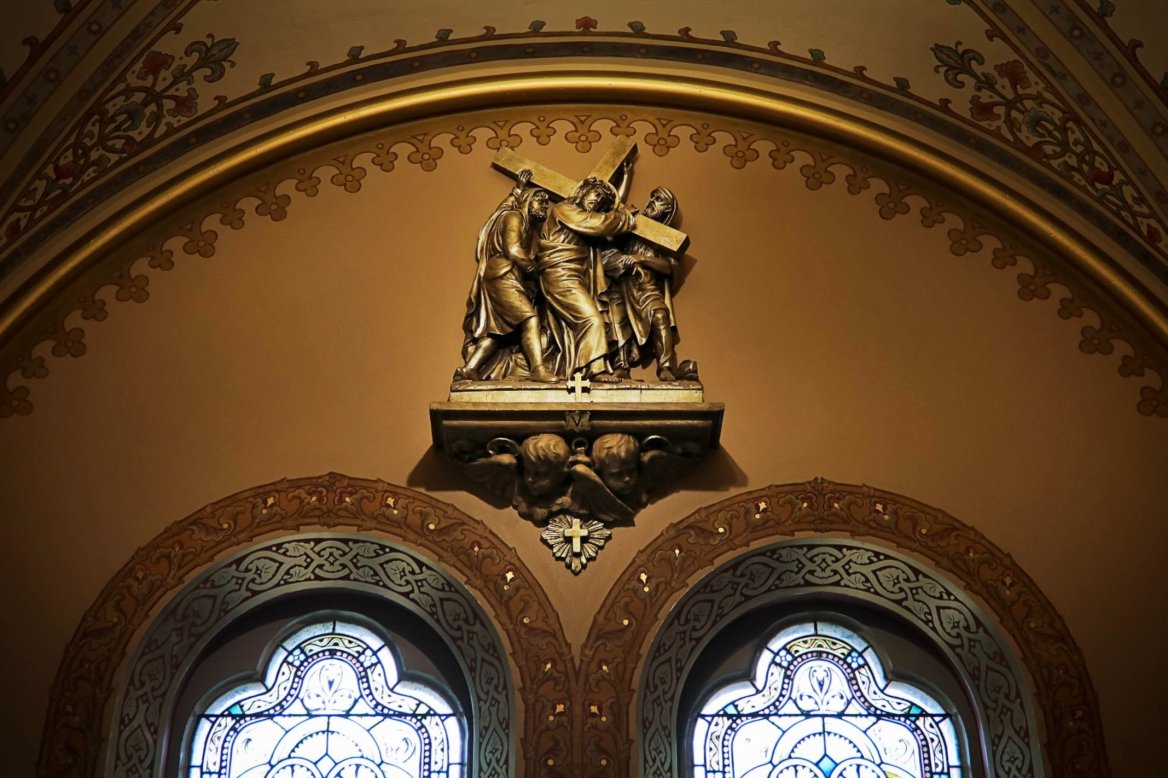
Stations of the Cross
Each of the fourteen Stations of the Cross located under the organ loft and above the double windows of the nave in Mary of the Angels Chapel were hand carved from bronzed beech wood by the Hackner Altar Company. Designed specifically for our chapel, each group of statuary is supported by a decorative bracket in stucco and portrays the passion, death and burial of Jesus Christ.
Organ
A Casavant Freres, mechanical (tracker) action, pipe organ was installed in Mary of the Angels chapel in 1983. When the original organ had to be replaced, it was deemed desirable that the new organ would be commensurate with the style and architecture of the chapel. The current organ, made mainly of wood, has 1,422 pipes, 20 stops and 30 ranks played using two keyboards and various pedals.
Perpetual Adoration Chapel:
The Chapel of Perpetual Adoration serves as the Franciscan Sisters' namesake. Since August 1, 1878, day and night without interruption, FSPA members and prayer partners have kept vigil before the Blessed Sacrament exposed, praying for our community, the church, the city and the world. This chapel is dedicated to the Sacred Heart of Jesus.
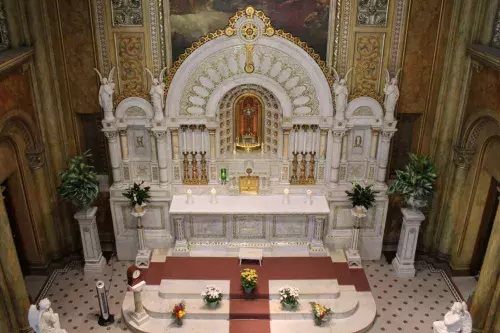
Main Altar
This Romanesque architecture designed altar is unique in form and ornamentation and complements the altar in the Mary of the Angels Chapel. However, the gold bronzes are lighter and richer, the mosaic more exquisite and the symbols fewer and simpler than those in the larger chapel.
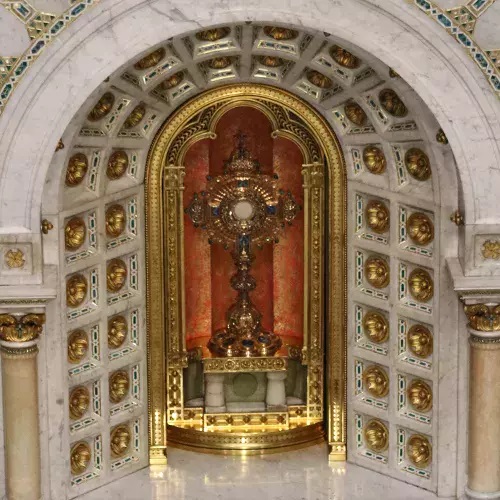
Monstrance
Harmonizing with the architectural scheme of the chapel, the monstrance of exposition is of artistic workmanship. It is Romanesque in style; gold plated over a silver base and thirty inches high. The focus of the Adoration Chapel is the revolving tabernacle supporting the monstrance with the Blessed Sacrament exposed. The platform holds the monstrance on the Adoration Chapel side and the crucifix on the Mary of the Angels Chapel side.
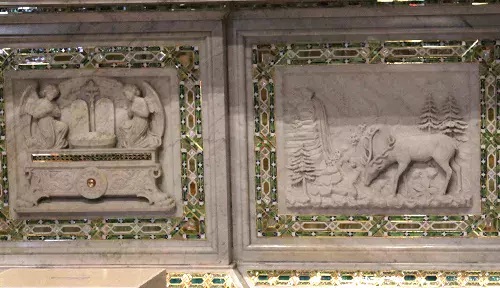
Relief Sculptures
The three beautifully carved panels designed and executed by the celebrated altar builder E. Hackner, are strictly liturgical in design and symbolic of the mysteries of Faith. These three panels appear on the frontals below the mensa of the altar, and represent the font of the living water, ark of the covenant, and deer drinking of living water.
Paintings
Paintings in the Perpetual Adoration Chapel represent the adoration of the Eucharist and the mystery of the Blessed Trinity, along with portrayals of saints of the Eucharist. Like those in the sanctuary of the Mary of the Angels Chapel, the paintings are the work of the renowned artist Thaddeus von Zukotynski, Chicago, Illinois.
Windows/Stained Glass
The windows in the Perpetual Adoration Chapel represent Mary, Queen of Angels, as the central theme, or figure, surrounded by the nine choirs of angels in the other nine windows respectively. Beautiful in design and coloring, they were made from original patterns submitted by the Hackner Altar Company to the Bavarian Art Studio at Munich, Bavaria.




